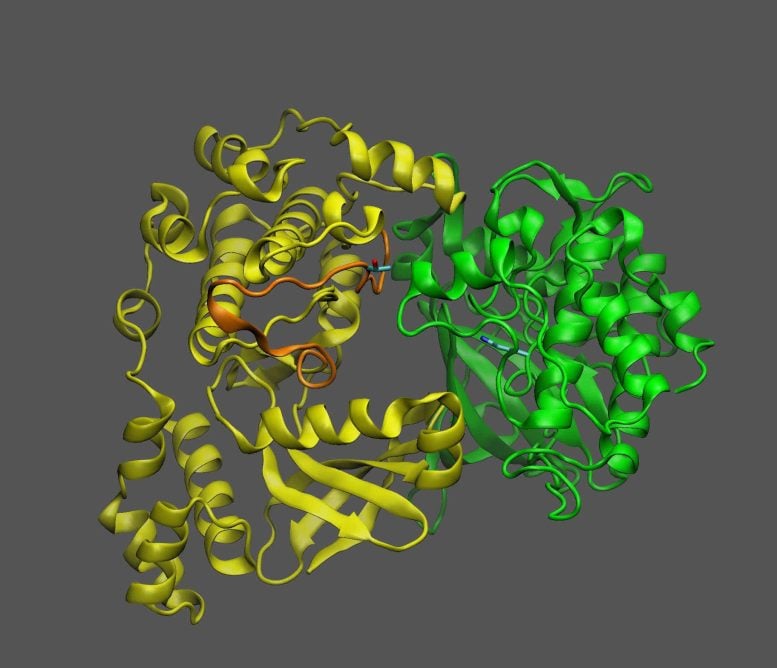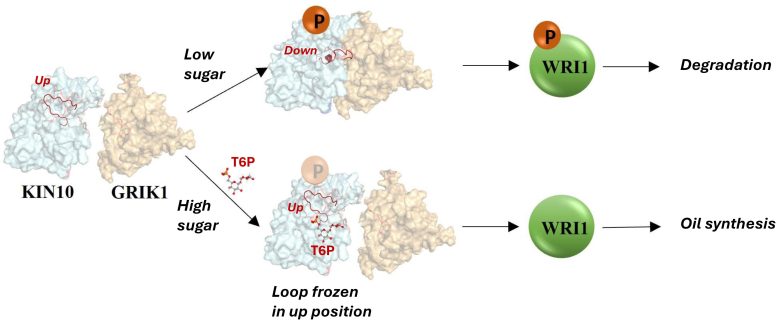Recent research by the Brookhaven National Laboratory explores how plant proteins respond to sugar levels. The study reveals that the sugar proxy molecule’s binding to the KIN10 protein influences plant growth and oil production. This insight could lead to genetic modifications in plants to enhance oil output for biofuels. Credit: SciTechDaily
A new study shows how sugar levels influence plant growth and oil production through the protein KIN10, offering the potential for advancements in biofuel production.
Proteins function as molecular machines, equipped with flexible components and moving parts. Gaining insight into these movements is crucial for scientists as it helps them understand the role a protein plays in organisms, and it may also guide them in modifying its effects. A team of biochemists from the U.S. Department of Energy’s Brookhaven National Laboratory and the Pacific Northwest National Laboratory have provided new insights into the mechanisms of these molecular machines within plants.
In their recent study, published in 
This image shows a plant protein known as KIN10 (yellow) that acts as a sensor and a switch to turn oil production off or on depending on whether it interacts with another protein (green). Credit: Brookhaven National Laboratory
Molecular Mechanisms Unveiled
Jantana Blanford, a Brookhaven Lab biochemist and the study’s lead author, explains, “This paper reveals the detailed mechanism by which plant cells are informed of high sugar availability, influencing biochemical pathways that facilitate plant growth and oil production.”
The research expands upon earlier work from Brookhaven’s team that uncovered molecular links between sugar levels and oil production in plants. One potential goal of this research is to identify specific proteins and their components that scientists can engineer to make plants produce more energy-intensive products, such as oil.
“Identifying exactly how these molecules and proteins interact, as this new study does, brings us closer to identifying how we might engineer these proteins to increase plant oil production,” said John Shanklin, lead author and chair of Brookhaven Lab’s Biology Department.
This animation shows how a flexible loop (orange) on a plant protein known as KIN10 (yellow) allows it to interact with another protein (green) — but only when sugar levels are low. The interaction of the two proteins triggers a cascade of reactions that break down other proteins involved in oil synthesis so the plant can conserve its resources. When sugar levels are high, meaning the plant has abundant resources, a sugar-proxy molecule blocks the loop’s swinging motion. That prevents the protein interaction, which keeps the oil-production pathway open. Credit: Brookhaven National Laboratory
New Research on Protein Interactions
The team used a combination of laboratory experiments and computational modeling to zero in on how the molecule that serves as a sugar proxy binds to a “sensor kinase” known as KIN10. KIN10 is the protein that contains the moving parts that determine which biochemical pathways are on or off.
The scientists already knew that KIN10 acts as both a sugar sensor and a switch: When sugar levels are low, KIN10 interacts with another protein to set off a cascade of reactions that ultimately shut down oil production and break down energy-rich molecules like oil and starch to make energy that powers the cell. But when sugar levels are high, KIN10’s shut-down function is shut off — meaning plants can grow and make lots of oil and other products with abundant energy.

This diagram shows the two pathways KIN10 and an adjacent protein, GRIK1, follow in the low- and high-sugar conditions. Low sugar allows the addition of a phosphate (P) to KIN10, which triggers a phosphorylation cascade that leads to the breakdown of enzymes involved in oil synthesis. This includes degradation of WRI1, the master-switch for oil synthesis. When sugar is abundant, however, a sugar-proxy molecule (T6P) binds to the KIN10 loop to block its interaction with GRIK1. That keeps the oil synthesis pathway open. Credit: Brookhaven National Laboratory
To identify how the sugar proxy binding to KIN10 flips the switch, Blanford started with the adage “opposites attract.” She identified three positively charged parts of KIN10 that might be attracted to abundant negative charges on the sugar proxy molecule. A laboratory-based process of elimination that involved making variations of KIN10 with modifications to these sites identified the one true binding site.
Then the Brookhaven team turned to computational colleagues at PNNL. Marcel Baer and Simone Raugei at PNNL examined at the atomic level how the sugar proxy and KIN10 fit together. “By using multiscale modeling we observed that the protein can exist in multiple conformations but only one of them can effectively bind the sugar proxy,” Baer said.
The PNNL simulations identified key 
Brookhaven Lab members of the research team: Jantana Blanford, Zhiyang Zhai, Hui Li, Qun Liu, and John Shanklin (not shown: Gongrui Guo). Credit: Brookhaven National Laboratory
The Role of Flexibility in Protein Function
“Additional analyses showed that the entire KIN10 molecule is rigid except for one long flexible loop,” Shanklin said. The models also showed that the loop’s flexibility is what allows KIN10 to interact with an activator protein to trigger the cascade of reactions that ultimately shut down oil production and plant growth.

Pacific Northwest National Laboratory co-authors Marcel Baer and Simone Raugei. Credit: Pacific Northwest National Laboratory
When sugar levels are low, and little sugar proxy molecule is present, the loop remains flexible, and the shutdown mechanism can operate to reduce plant growth and oil production. That makes sense to conserve precious resources, Shanklin said. However, when sugar levels are high, the sugar proxy binds tightly to KIN10.
“The calculations show how this small molecule blocks the loop from swinging around and prevents it from triggering the shutdown cascade,” Blanford said.
“We could potentially use our new knowledge to design KIN10 with altered binding strength for the sugar proxy to change the set point at which plants make things like oil and break things down,” Shanklin said. This knowledge could lead to more efficient production of biofuels and other oil-based products.
Reference: “Molecular mechanism of trehalose 6-phosphate inhibition of the plant metabolic sensor kinase SnRK1” by Jantana Blanford, Zhiyang Zhai, Marcel D. Baer, Gongrui Guo, Hui Liu, Qun Liu, Simone Raugei and John Shanklin, 17 May 2024, Science Advances.
DOI: 10.1126/sciadv.adn0895
This work was supported by the DOE Office of Science (BES). Computer time was provided by the National Energy Research Scientific Computing Center (NERSC) at Lawrence Berkeley National Laboratory and the Molecular Sciences Computing Facility (MSCF) in the Environmental Molecular Sciences Laboratory at Pacific Northwest National Laboratory. NERSC and MSCF are DOE Office of Science user facilities.











/https://tf-cmsv2-smithsonianmag-media.s3.amazonaws.com/filer_public/34/31/3431771d-41e2-4f97-aed2-c5f1df5295da/gettyimages-1441066266_web.jpg)







Discussion about this post